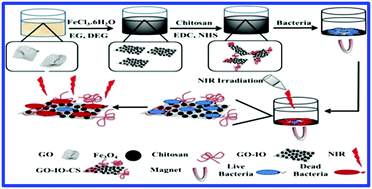Versatile graphene-based photothermal nanocomposites for effectively capturing and killing bacteria, and for destroying bacterial biofilms†
Abstract
Bacterial infection is a worldwide health problem. Finding new potential antibacterial materials and developing advanced treatment strategies are becoming increasingly important and urgent. Herein, a versatile graphene-based photothermal nanocomposite was prepared for rapidly capturing and effectively eliminating both Gram-positive Staphylococcus aureus (S. aureus) and Gram-negative Escherichia coli (E. coli), and for destroying bacterial biofilms with near-infrared (NIR) irradiation. In this work, chitosan-functionalized magnetic graphene oxide (GO–IO–CS) was synthesized as a multifunctional therapy agent through a hydrothermal method. Chitosan could efficiently contact and capture bacteria by its positively charged surface functional groups, and graphene oxide could act as an effective photothermal killer to convert NIR light into local heat to enhance antibacterial activity. The super-paramagnetic properties of GO–IO–CS made it easy to separate and aggregate the bacteria, so improving the photothermal sterilization efficiency. GO–IO–CS was demonstrated to eliminate bacteria effectively after 10 min of NIR irradiation and to destroy bacterial biofilms. Furthermore, this antibiotic agent could be regenerated with an external magnet and reused in a subsequent antibacterial application.



 Please wait while we load your content...
Please wait while we load your content...